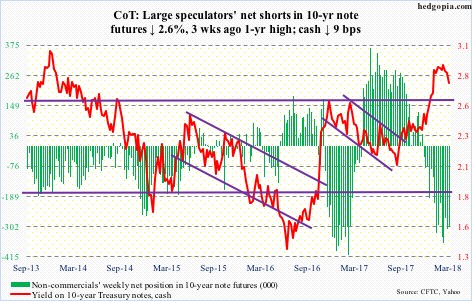Following futures positions of non-commercials are as of March 27, 2018.
10-year note: Currently net short 305.2k, down 8.1k.
For the first time since mid-December last year, 10-year Treasury yields went under the 50-day moving average this week. On March 21 – the day the FOMC concluded its two-day meeting by raising the fed funds rate by 25 basis points – the 10-year rose intraday to 2.94 percent to match the high from February 21. We now have two back-to-back months of failure at that level.
A convincing breakout would mean the 10-year rate would finally break free of a three-decade-old descending channel. Leading into this, the majority thought the bull market in U.S. bonds was over and that the channel would soon give way. It is still intact.
In the right circumstances for bond bulls, yields can still head lower. Particularly if non-commercials are forced/tempted to reduce their massive net shorts in 10-year note futures. Yields (2.74 percent) can go test resistance-turned-support at 2.62 percent, which was taken out in January this year, after failing in December 2016 and then again in March 2017.
That said, it is a toss-up in the very near term. For five-six weeks now, 10-year yields have traded within a slightly declining channel, and are currently at the low end of it.
30-year bond: Currently net long 44.8k, down 7.7k.
Major economic releases next week are as follows.
The ISM manufacturing index for March is published on Monday. (February rose 1.7 points month-over-month to 60.8, which was the highest since 61.4 in May 2004.)
Wednesday brings the ISM non-manufacturing index (March) and durable goods (February, revised).
Services activity in February came in at 59.5. January’s 59.9 was the highest ever (data only goes back to January 2008.)
The advance report for February showed orders for non-defense capital goods ex-aircraft – proxy for business capex plans – rose eight percent year-over-year to a seasonally adjusted annual rate of $67.8 billion. Orders peaked at $70.3 billion in September 2014, and have been rising since bottoming at $59.9 billion in May 2016.












Leave A Comment